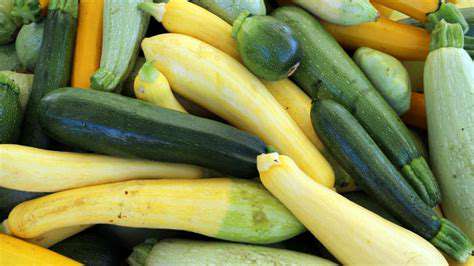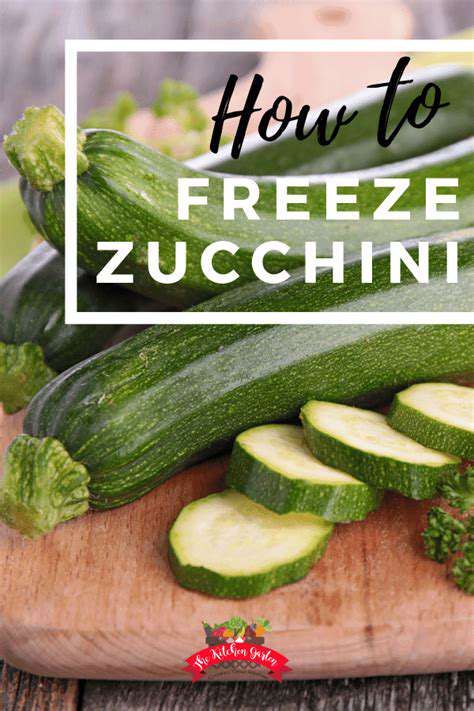How to Store Zucchini: Keep Them Fresh

Extending Zucchini's Freshness with Freezing

Preserving Zucchini's Flavor
Zucchini, with its delicate flavor and vibrant green hue, is a summer culinary staple. To maximize its freshness and extend its shelf life, proper handling and storage techniques are crucial. Maintaining its crisp texture and preventing premature wilting are key to enjoying its flavor throughout the season.
Employing simple preservation methods such as blanching and freezing can significantly extend the time you can enjoy zucchini. Blanching helps to maintain the zucchini's texture and color, and freezing ensures a readily available supply for later use in recipes.
Blanching Techniques for Zucchini
Blanching involves briefly submerging the zucchini in boiling water to stop the enzymatic reactions that cause it to lose its freshness. This process, while seemingly simple, is critical in preserving its quality. By quickly shocking the zucchini in ice water, you effectively halt the cooking process and maintain its vibrant green color.
After blanching, the zucchini can be easily frozen for later use. Properly blanched and frozen zucchini can be utilized in countless recipes, adding a burst of summer flavor to your meals well into the fall and winter months.
Freezing Zucchini for Future Use
Freezing zucchini is a convenient method for preserving its freshness and flavor. After blanching, spread the zucchini pieces on a baking sheet lined with parchment paper to prevent sticking. This allows the zucchini to freeze in a flat layer, making it easier to portion and use later.
Once frozen solid, transfer the zucchini to freezer bags or containers, ensuring that they are completely sealed to maintain freshness and prevent freezer burn. Properly stored, frozen zucchini can remain fresh for several months.
Dehydrating Zucchini for Long-Term Storage
Dehydrating zucchini is another excellent method for extending its shelf life. This process removes moisture from the zucchini, preventing bacterial growth and extending its usable lifespan significantly. The result is a crunchy, concentrated zucchini that can be used in various dishes.
The process involves slicing the zucchini thinly and placing it on a dehydrator tray. This method allows the zucchini to dry completely, creating a shelf-stable product that can be stored in airtight containers at room temperature for several weeks.
Pickling Zucchini for a Tangy Twist
Pickling zucchini adds a tangy and flavorful dimension to the vegetable. This method preserves the zucchini's freshness while transforming its taste profile. Pickling involves submerging the zucchini in a brine solution, creating a delicious and versatile addition to salads, sandwiches, and other dishes.
The process involves creating a brine solution with vinegar, sugar, salt, and spices. The zucchini is then submerged in the solution, allowing the flavors to meld and the zucchini to maintain its texture and color while being preserved.
Zucchini's Nutritional Advantages During Storage
Interestingly, even after preservation, zucchini retains a significant portion of its nutritional value. Vitamins and minerals like Vitamin C and potassium are preserved through proper preservation methods. These nutrients remain readily available for consumption, regardless of the method used to extend the zucchini's freshness.
Consuming preserved zucchini contributes to a balanced diet, offering vitamins and minerals that support overall health. This makes preserving zucchini a practical way to maximize nutritional intake throughout the year.
Optimizing Zucchini Storage for Best Flavor and Texture
Proper Harvesting for Optimal Storage
Harvesting zucchini at the peak of ripeness is crucial for ensuring optimal storage. Picking them when they're still firm, but not overly hard, is key. Overly ripe zucchini will have a diminished flavor and texture, making them less appealing to store. Carefully remove the zucchini from the vine, taking care not to damage the skin or introduce any bruising that could lead to spoilage. Proper handling during harvesting significantly impacts the quality of the zucchini you'll be able to enjoy later.
Timing your harvest is also essential. If you're aiming for long-term storage, harvesting slightly earlier in the growing season, when the zucchini is smaller, might be preferable. This will allow for a firmer texture and better preservation. Also, consider the specific variety of zucchini you are growing. Different types may have varying optimal harvest times, impacting their storage potential.
Choosing the Right Storage Method
The method you choose for storing zucchini significantly influences its longevity and quality. For short-term storage (a few days to a week), a cool, dry place in the refrigerator is ideal. Placing the zucchini in a perforated plastic bag will help maintain moisture while preventing over-ripening. This is a good option for zucchini you plan to use within a week for salads, stir-fries, or other quick dishes.
For longer-term storage (a few weeks to a month), consider a cool, dark, and well-ventilated area like a root cellar or a crisper drawer in your refrigerator. Properly storing zucchini in these environments can help to slow down the ripening process and maintain its freshness. These storage methods are best suited for preserving zucchini for longer periods, like using it for soups, stews, or freezing.
Controlling Moisture and Temperature
Maintaining the right moisture levels is vital to preventing zucchini from drying out or rotting. Avoid storing zucchini near overly moist produce, as this can lead to rapid deterioration. Temperature control is equally crucial. High temperatures accelerate the ripening process, leading to a loss of flavor and texture. Storing your zucchini in a cool environment helps slow down this process significantly, ensuring that it retains its crispness and flavor for longer.
Preventing Spoilage and Pests
Proper handling and storage can help prevent zucchini from spoiling. Inspect the zucchini for any signs of damage or pests before storing. Any blemishes or signs of infestation should be addressed immediately. Proper cleaning and sanitizing of the storage area can also help reduce the risk of contamination from pests or microorganisms. This includes wiping down surfaces and ensuring that any containers you are using are clean and free of potential contaminants.
Freezing Zucchini for Extended Storage
Freezing zucchini is an excellent way to preserve it for use throughout the year. Freezing methods, such as blanching before freezing, help to maintain the quality and texture of the zucchini. Blanching involves briefly submerging the zucchini in boiling water before quickly chilling it in ice water. This process helps to inactivate enzymes that cause changes in flavor and texture. Properly freezing zucchini allows you to enjoy its deliciousness in various dishes, even in the off-season.
Freezing zucchini is a great way to preserve a large harvest. Slice the zucchini into desired shapes and store them in freezer bags or containers. Be sure to label and date your frozen zucchini to ensure you use the oldest items first. This preservation method allows you to enjoy the taste of summer zucchini throughout the year, making it an excellent way to use any excess you might have.
- How to Choose the Freshest Seafood at Your Market
- Low Sugar Meals: Balanced and Flavorful
- Unveiling Spanish Tapas: Small Plates, Big Flavor
- Gluten Free Baking Tips: Success Every Time
- Meal Planning for Beginners: Your First Week of Easy Meals
- Quick & Easy Lunches: Delicious and Nutritious
- Healthy Snack Recipes: Guilt Free Indulgences
- Authentic Vietnamese Spring Roll Sauce: Nuoc Cham
- Authentic Argentine Asado: Grilling Techniques
- How to Store Fresh Corn: Keep It Sweet
- Storing Chocolate: Prevent Blooming
- Buying Fresh Produce: Tips for Picking the Best